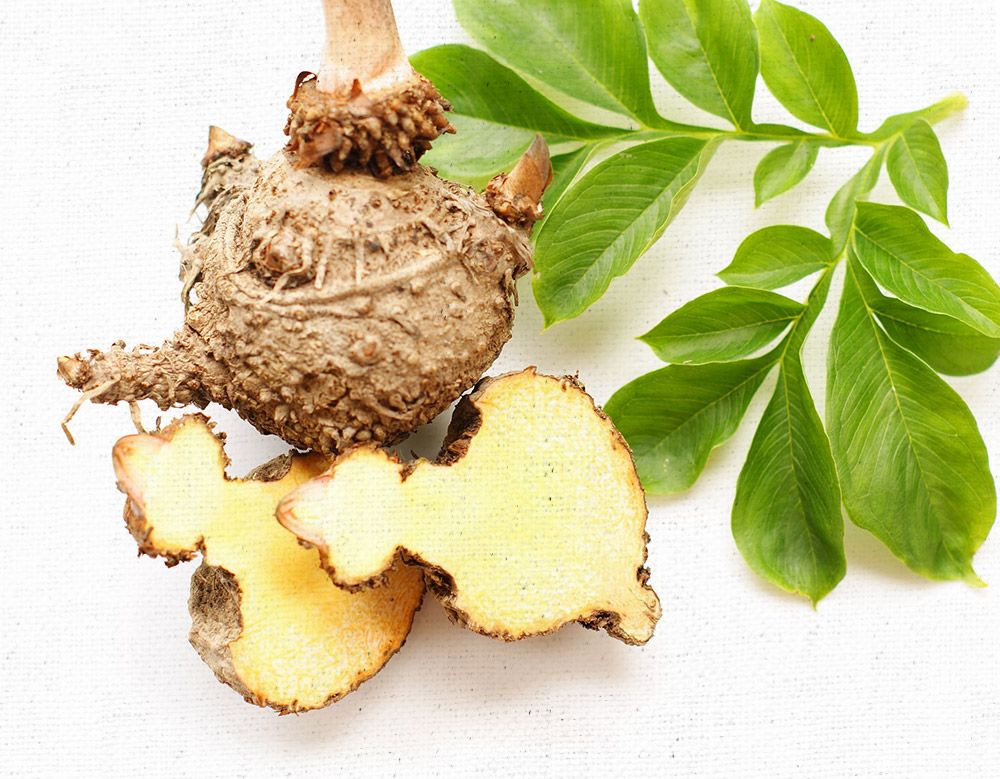MAKING SHIRATAKI NOODLES (KONJAC POWDER NOODLES):
- Konjac is a powerful thickener that quickly adds viscosity to liquids. This makes it ideal for using in healthy cooking. Shirataki noodles, made with konjac root, have a similar texture to grain noodles, but do not absorb liquid, thus you have to use a thickener to get your sauce to adhere well to them. Why use a thickener like corn starch when you can use konjac powder, which thickens even better, helps promote feelings of fullness, and has a myriad of potent health benefits?
- Konjac powder can be used in beverages, sauces, and even baked goods. It thickens quickly, so make sure you stir or mix it into your food immediately once it is added. Start with a small amount, and add more as needed.
PREPARATION: RINSE AND DRY NOODLES
-
- Shirataki noodles come packed in water. Although they are relatively tasteless they have an unpleasant fishy odour, which once they are rinsed and properly prepared, disappears. Do not be alarmed. This odour is normal, and really doesn’t affect the smell or taste of your finished dish. Likewise, once konjac powder is added to other foods, the smell is virtually undetectable.
- Because konjac is such a powerful thickener, you can load up your shirataki noodle recipes with lots of non-starchy veggies to boost nutrition and portion size. The konjac powder you add will absorb any excess liquid released by your vegetables as they cook, creating silky smooth sauces, and dishes light on carbs and calories, but loaded with nutrition.
- When making dishes with shirataki noodles, start with a thick, flavourful sauce for best results, using things like nut and seed butters, miso, coconut milk and milk powder, tomato paste, avocado, umeboshi plum paste, etc. Add some konjac powder (1 tsp) and stir. Wait a minute or 2 to let your sauce thicken before adding any more.
- Be sure to choose the shirataki noodles made from only konjac fibre for Asian-style dishes. These can also be used for Italian dishes, or you can use the ones with tofu added, which do have some carbohydrates and calories.
- There are a few things to keep in mind when cooking with konjac products. Once mixed with a liquid, the powder can swell so much that it can be a choking hazard for small children or individuals who have difficulty swallowing (Chua et al., 2002). Thus, it is important to use the powder judiciously in your recipes. Start with a small amount and only add more, as needed. Make sure there are no big lumps of powder in your dish. Good quality konjac powder is less likely to clump. Also, work quickly. It doesn’t take long for it to thicken liquid.
- For best results, shirataki noodles cannot be treated exactly like grain or other starch-based noodles because they do not absorb liquid. This makes them ideal for soups, because they will never get mushy or disintegrate in broth, however; this also means that thin sauces can make your dish turn out too watery, particularly if your recipe includes a lot of vegetables or other ingredients that release a lot of water when cooking. For best results, shirataki noodles should be drained and rinsed well and then ‘dried’. The drying process involves placing the noodles in a dry fry pan or skillet on medium/high heat and heating until any excess liquid evaporates. Then they are ready to use in virtually any hot or cold noodle dish. For soups, you can omit the drying step. If using konjac powder to thicken your sauce, you only need to rinse the noodles, you do not need to dry them.
- For stir-fries or other Asian-style dishes, you want to make a highly flavoured sauce, thickened with things like nut or seed butters, tomato paste, coconut milk powder and/or avocado and generally limit the liquid you add to a few tablespoons of soy sauce, rice vinegar, fish sauce and/or lime juice. With the tofu shirataki noodles, Italian-style dishes can be created using canned or fresh tomatoes, pestos and/or dairy or non-dairy creamy sauces. In addition, if you want to thicken your favorite recipe to make it appropriate to use with shirataki noodles, you can add a small amount of konjac powder to your sauce, and this will also increase the satiety of the dish and the potential health benefits.
- Konjac powder also has many other uses in cooking and baking. It can be used to thicken puddings, smoothies, salad dressings or frostings, and as a binder in meats, and vegetarian meat-alternatives. Konjac powder can be added to baked goods to add tenderness, lower the glycemic index, and promote feelings of fullness. While konjac powder is more expensive than other gums, starches or thickeners, it has more potential health benefits and a little goes a very long way.
KONJAC TIPS
1. When thickening a hot sauce or recipe, start with a small amount of konjac powder, and add more as needed.
2. Blend konjac into your recipe quickly to avoid lumps.
3. Remember that konjac will continue to thicken your recipe as it sits. Puddings, jams, etc. will set after they cool in the refrigerator.
4. Add konjac into your diet gradually, as you would do for any type of fibre, to allow your body to adjust to it.
5. Konjac makes everything more filling, start with a small portion of each recipe until you see how much you need to eat in order to feel satisfied (but not too stuffed!).

